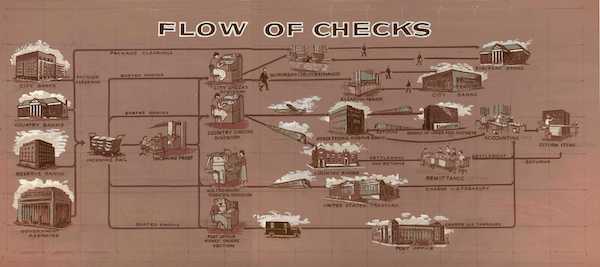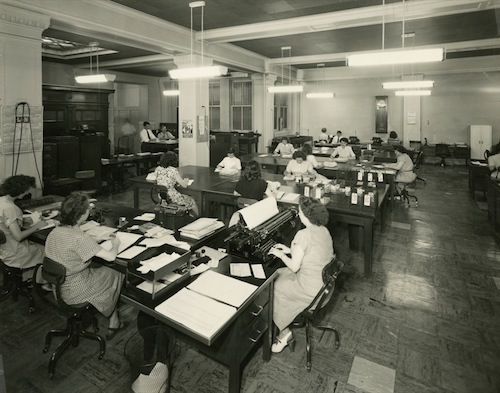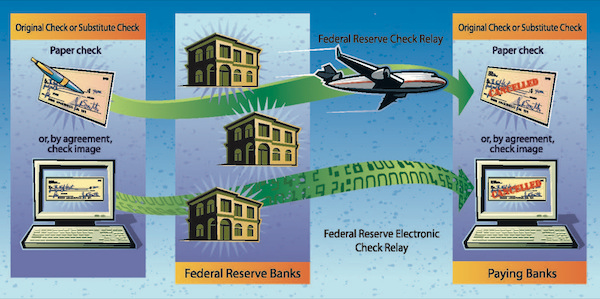Today, depositing a check is as simple as two snaps of a cellphone camera. It’s hard to imagine that the system used to involve teams of people, trains, planes, and automobiles, or that often a person had to pay to get a check processed!

Artist Roscoe Misselhorn created this mural in 1957 to illustrate how paper checks were processed by the Federal Reserve Banks and their branches in an era before electronic processing.
When the Federal Reserve was established in 1914, Congress’s expectations for it included increasing the efficiency of check processing and eradicating “nonpar banking.” Under nonpar banking, banks charge a fee for processing a check, paying customers “less than their face value.”[1] A par collection system instead pays customers checks that are worth their full value.
As part of its work to stabilize the financial system, the Federal Reserve established a “countrywide par collection system” on July 15, 1916, that greatly reduced the cost of check collection by decreasing the service charge to 1 ½ cents or less.[2] In 1917, Congress amended the Federal Reserve Act to allow nonmember banks to participate in this system, and later the Federal Reserve eliminated service charges altogether for member banks.
Technology and innovation also played a major role in the evolution of check processing during this decade. In 1918, the Leased Wire System was developed to allow Federal Reserve Banks to transfer funds and send messages via telegraph (the current version[3] of this system, Fedwire, uses computers instead). Once it was unnecessary for banks to “settle check payments by shipping notes, bank drafts, or coin,” check processing became much speedier. In fact, in New York it was found that the average time it took to collect checks “drawn on banks from remote cities” was reduced from 5.3 days in 1912 to 2.4 days in 1918 because of the implementation of Fedwire. [4]
Now that clearing checks through the Federal Reserve was faster and cheaper, the number of banks utilizing its services rapidly increased. Since the Federal Reserve’s check processing system was a par collection system, its expanding use also helped to normalize at-par banking. Consequences of the Great Depression, including the closure of many commercial banks and faltering confidence in their “private clearing arrangements”[5] also contributed to the rise in popularity of the Federal Reserve’s check clearing services.

In 1948, workers in the Check Collections Section carry out their various tasks. Checks were processed manually with typewriters and adding machines.
A combination of the growth of the Federal Reserve’s check clearing system and the increased demand for checks prompted by the postwar expansion of the 1940s and 50s put significant strain on check processing, which was largely still done by hand.[6]The answer to this problem was the invention of magnetic ink character recognition (MICR) technology in the late 1950s.[7]MICR was used to print characters in a standardized font and location on the check face, which enabled machines to read and sort them at a rapid pace.[8] By September 1, 1967, the Federal Reserve Bank required all cleared checks to be encoded with MICR.[9]
In the 1970s, the Federal Reserve further improved the efficiency of check processing by developing remote check processing centers (RCPCs) and automatic clearinghouses (ACHs). Opened around the country in 1972, RCPCs were established in “strategic locations”[10] in order to provide faster payment services to more people.[11] Another important moment of the early 1970s was the invention of automatic clearinghouses, which were developed as a “more efficient alternative to checks.”[12] ACHs were systems of computers capable of “clear[ing] and sort[ing] payments instructions recorded on magnetic tapes.” In 1978, the Federal Reserve established a “nationwide network” that linked together the 35 automatic clearinghouses in use to create a system that connected every corner of the country. [13] The ACH system is still used to process payments today, including many of the transactions made via phone and internet.
At the same time that an enormous amount of checks were being processed in the 1970s, the economy was also experiencing high inflation and high interest rates.[14] This created a problem with “check float,” where delays in check processing cause money to essentially be in two places at once. In technical terms, check float is generated “when a Reserve Bank credits a bank for depositing a check but has not yet collected funds from the bank upon which the check is drawn” because for a brief period before the Bank collects these funds, both banks have access to it. Companies learned that they could take advantage of the situation. Since high inflation caused the average dollar amount of checks to be higher and interest rates were also high, by “drawing funds from far-away banks,” they could extend the amount of time it took to process a check, potentially earning interest on the funds. Check processing was also increasing, so this combination of high check volume, high interest rates, and high inflation caused daily average check float to reach $6.6 billion between 1975 and 1979.[15] In response, the Monetary Control Act of 1980 was passed, requiring banks to charge interest for float.
After experimenting with transmitting checks electronically in the 1980s, the Federal Reserve finally started offering electronic check presentment to banks in the 1990s by using checks’ MICR codes to acquire and transmit data.[16] Unfortunately, the majority of banks “continued to simply demand that original checks be presented for payment,” so check processing remained dependent on physical checks.[17] In 1992, the daily average volume of checks collected through the Federal Reserve peaked at 19.1 billion. However, as other electronic payment methods such as debit/credit cards and ACH payments gained popularity, the use of checks began to decline.[18]

This graphic demonstrates how the Check 21 legislation enacted in 2003 gave banks that process checks the options to convert paper checks into electronic images.
The Check Clearing for the 21st Century Act, commonly referred to as Check 21, made electronic check presentment easier and more intuitive. It was passed partly in reaction to 9/11, which “disrupted the air transport of checks to paying banks.”[19] Before Check 21, “all financial institutions in the collection process” had to agree to process a specific check electronically in order for it to occur. If not every institution agreed, “original paper checks had to be presented to the institution on which they were drawn.” However, Check 21 simplified this by introducing the concept of a “substitute check,” which is a “special paper copy of the front and back of an original check that is the legal equivalent of the original.” [20] Substitute checks can be used in place of originals, meaning that all institutions involved in processing a check no longer need to agree on whether or not to process it electronically; instead, individual institutions that require a physical check can print out a copy of the substitute check, not interfering with the decisions of other institutions.[21] Currently, the vast majority of checks processed by the Federal Reserve are received as electronic check images.[22]
In our increasingly digital world, the future of the check is shrouded in uncertainty. Scanning technology and app-based mobile payment methods have made it possible to use phones—even smartwatches—to make purchases, making it easy to imagine a world where paper checks no longer exist. Want to stay up to date with the latest updates in payment system technology? Check out the Federal Reserve System’s Payment Systems page.
[1] Federal Reserve System. “Fostering Payment and Settlement System Safety and Efficiency.” The Federal Reserve System: Purposes & Functions, October 2016: 124
[2] Federal Reserve Bank of New York. “43. Details of the Collection and Clearing System.” Federal Reserve Bank of New York Circulars, June 6, 1916
[3] Fed publications from the time seem to show that the wire system was gradually renamed over the course of the 1970s, from “the Fed’s wire system” to “Fed Wire” to “Fedwire.” For more background on Fedwire’s development, see Adam Gilbert, Dara Hunt, and Kenneth C. Winch. “Creating an integrated payment system: The evolution of Fedwire.” Federal Reserve Bank of New York Economic Policy Review 3, no. 2 (1997): 1-7.
[4] Stephen Quinn and William Roberds. “The evolution of the check as a means of payment: A historical survey.” Economic Review (Federal Reserve Bank of Atlanta), 2008: 17.
[5] Ibid., p. 18-19.
[6] Ibid., p. 20.
[7] Federal Reserve Bank of Atlanta. “The Bank in the 1960s.” A History of the Federal Reserve Bank of Atlanta, 1914-1989.
[8] Federal Reserve Bank of Cleveland. “Automated Check Processing.” Economic Review (Federal Reserve Bank of Cleveland), June 1960: 7-8.
[9] Federal Reserve Bank of St. Louis. “Automated Check Processing.” Review (Federal Reserve Bank of St. Louis), June 1967: 15.
[10] Federal Reserve Bank of St. Louis. “Operations of the Federal Reserve Bank of St. Louis – 1972.” Annual Report of the Federal Reserve Bank of St. Louis, December 31, 1972: 11.
[11] Federal Reserve Bank of St. Louis, 1967.
[12] Federal Reserve System. “Fostering Payment and Settlement System Safety and Efficiency.” The Federal Reserve System: Purposes & Functions, October 2016: 128.
[13] Federal Reserve Bank of San Francisco. “Nationwide EFT System Completed.” Federal Reserve Notes, October 1978: 1.
[14] Federal Reserve Bank of New York. “Float.” About the New York Fed, April 2007.
[15] Ibid.
[16] Federal Reserve Bank of Dallas. “Operating Circular 17 (Electronic Check Presentment Services).” District Notices 94-19, February 21, 1994.
[17] Federal Reserve Bank of New York, 2007.
[18] Geoffrey R. Gerdes and Kathy C. Wang. “Recent Payment Trends in the United States.” Federal Reserve Bulletin, October 2008: A75.
[19] Quinn and Roberds.
[20] Federal Reserve Bank of New York, 2013. “Check Processing.” About the New York Fed, March 2013.
[21] Quinn and Roberds.
[22] Federal Reserve Bank of New York, 2013.
© 2020, Federal Reserve Bank of St. Louis. The views expressed are those of the author(s) and do not necessarily reflect official positions of the Federal Reserve Bank of St. Louis or the Federal Reserve System.
